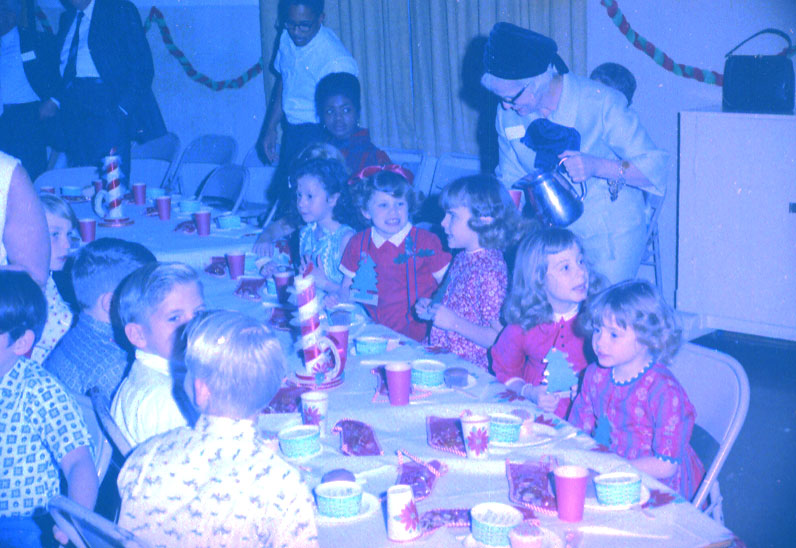
Photo of a Christmas Party at MacLaren Hall in the 1960's (photos courtesy of the archives of Mr. and Mrs. Vincent Graziano. Mr. Graziano volunteered as the Santa at
Mac Hall for years. Finding these photos was an amazing brush with luck, as my Archiving Professor for my Masters Degree, who was aware of my work on Mac Hall as a student, happened to
be Mr. Graziano's granddaughter!)
 I spent a large part of my Master's Degree program researching the history of MacLaren Hall. This book is the end result of that work. You can purchase
an ebook copy of this book on Amazon at http://www.amazon.com/American-Protection-History-MacLaren-Angeles-ebook/dp/B004JKMV0E. I am re-editing this book and will soon
have a paperback edition available along with a newly edited ebook version as well.
I spent a large part of my Master's Degree program researching the history of MacLaren Hall. This book is the end result of that work. You can purchase
an ebook copy of this book on Amazon at http://www.amazon.com/American-Protection-History-MacLaren-Angeles-ebook/dp/B004JKMV0E. I am re-editing this book and will soon
have a paperback edition available along with a newly edited ebook version as well.
MacLaren Hall was a Los Angeles County child protection institution for abused, unwanted, abandoned, orphaned, and neglected children. It was originally intended to keep "non-delinquent" minor (child) wards of the state who were in custody due to familial issues segregated from "delinquent" children who had committed crimes, as all were housed together in juvenile hall prior to MacLaren Hall. And although that was its original stated purpose, it quickly became an overflow facility for the county juvenile hall. In one form or another, Mac Hall was taking in children from the 1940's until 2003, and tens of thousands of children stayed at Mac Hall. It housed 4,000 children a year in 1964. (Los Angeles Times, County's Deprived Children Find a Home Away From Home, (1964, September 16), p. g9.)
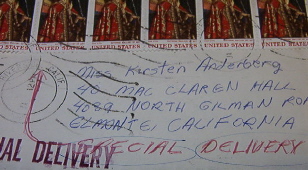
Letter addressed to me at MacLaren Hall, from my cousin, postdated January 1969
I was a resident of Mac Hall as an 8 year old child, in 1969, and can testify that it had many problems inherent to poorly funded public institutions. As a writer and historian, I have begun to collect information about the history of child protection institutions such as MacLaren Hall. I have also begun to compare and contrast the ways disenfranchised populations, especially children, have been treated by society throughout U.S. history.
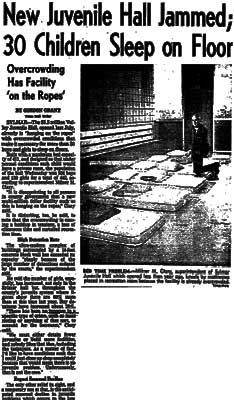
L.A. Times documents bed shortage at MacLaren Hall in this March 24, 1966 article.
Mac Hall was run like a jail, with "perimeter security measures, which include flood lights and a 14 foot chain link fence, topped by five feet of wire mesh (barbed wire)," according to a 1960 L.A. Times article. (Charles Gould, Los Angeles Times, New MacLaren Hall to House Juvenile Wards: Sister Kenny Polio Hospital Being Converted by Probation Department, (1960, November 6), p. sg1.) It turns out the Probation Dept. ran Mac Hall throughout the 40's - 70's, and thus, it was run the way they ran their prisons. They even hired "women probation attendants" via an ad run in the L.A.Times in 1961. (Los Angeles Times, Workers Sought for Hall Jobs, . (1961, January 15), p. sg_a15.) Eventually, County Social and Health Services ran Mac Hall.

Photo of a Christmas Party at MacLaren Hall in the 1960's (photos courtesy of the archives of Mr. and Mrs. Vincent Graziano. Mr. Graziano volunteered as the Santa at Mac Hall for years.)
In Michel Foucault's book, "Madness and Civilization," (N.Y.: Random House Press, 1965), he discusses abandoned institutional buildings being modified for new groups. He says that when leprosy was pretty must wiped out, they began to have all these large abandoned asylum complexes and thought about new populations for them, and that was the beginning of madhouses and workhouses. I thought about how institutional and asylum-like MacLaren Hall's buildings were when I was there, and after a bit of research, it turns out that the Mac Hall property was originally an institution built in 1936 by Ruth Kerr for young girls with venereal diseases and it then turned into the Sister Kenney Polio Hospital. After that, it turned into Mac Hall. So, that explains its institutional feel architecturally.
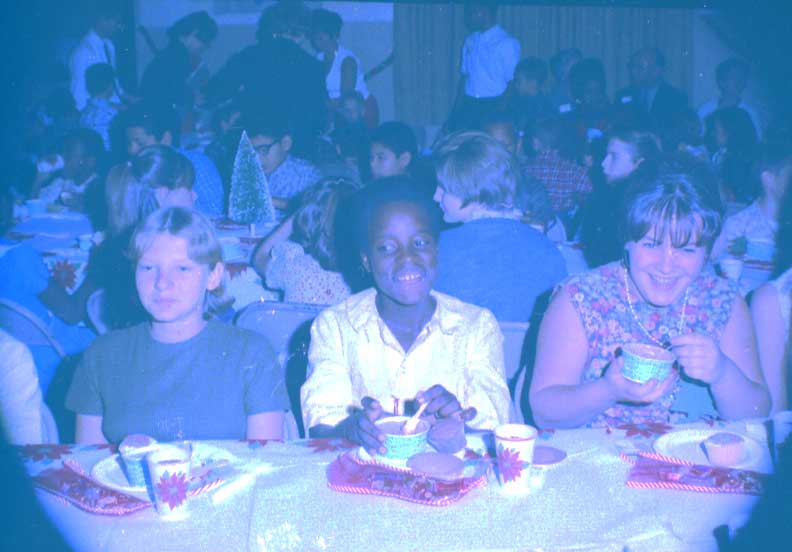
Photo of a Christmas Party at MacLaren Hall in the 1960's (photos courtesy of the archives of Mr. and Mrs. Vincent Graziano. Mr. Graziano volunteered as the Santa at Mac Hall for years.)
Camarillo State Mental Hospital was another Southern CA institution that held children in custody in jail-like settings. Camarillo State is located just north of Los Angeles County, in Ventura County. The L.A. Times reports that in the 1960's Camarillo staff would sometimes go to MacLaren Hall to pick up the more mentally ill children there, and some of the same children's doctors that worked at Camarillo State Hospital also worked at MacLaren Hall, and like Camarillo, MacLaren Hall used drugs to calm children down and make them more compliant, although thus far, all records of Mac Hall have been "misplaced," according to the County, thus we do not know what drugs were administered to children inside Mac Hall at this time.
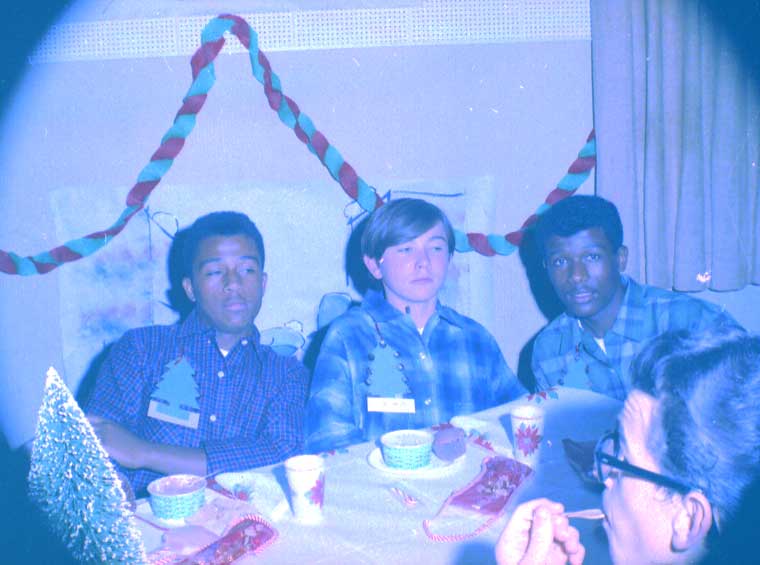
Photo of a Christmas Party at MacLaren Hall in the 1960's (photos courtesy of the archives of Mr. and Mrs. Vincent Graziano. Mr. Graziano volunteered as the Santa at Mac Hall for years.)
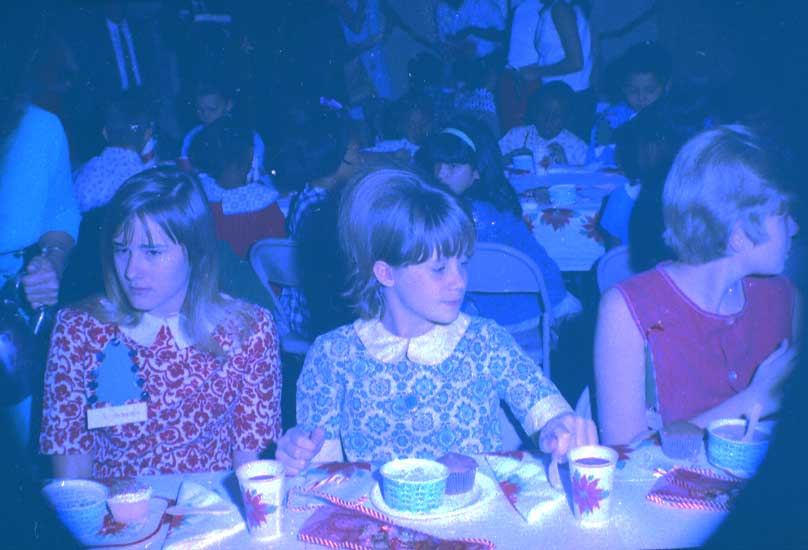
Photo of a Christmas Party at MacLaren Hall in the 1960's (photos courtesy of the archives of Mr. and Mrs. Vincent Graziano. Mr. Graziano volunteered as the Santa at Mac Hall for years.)
Los Angeles Times, April 26, 1959: “Construction work to prepare MacLaren Hall, former Sister Kenny Home, as a county home for juvenile girls is expected to begin soon so that facilities will be in operation by the end of this year. Bids for construction of 14 ft. high security fences and lighting will be opened… May 6…A condemnation suit for county acquisition of the property is pending in Superior Court. Because of the need for relieving overcrowded conditions at Juvenile Hall, the board approved leasing MacLaren Hall for an interim period. That will allow the county to enter the property and begin the necessary remodeling work immediately.”
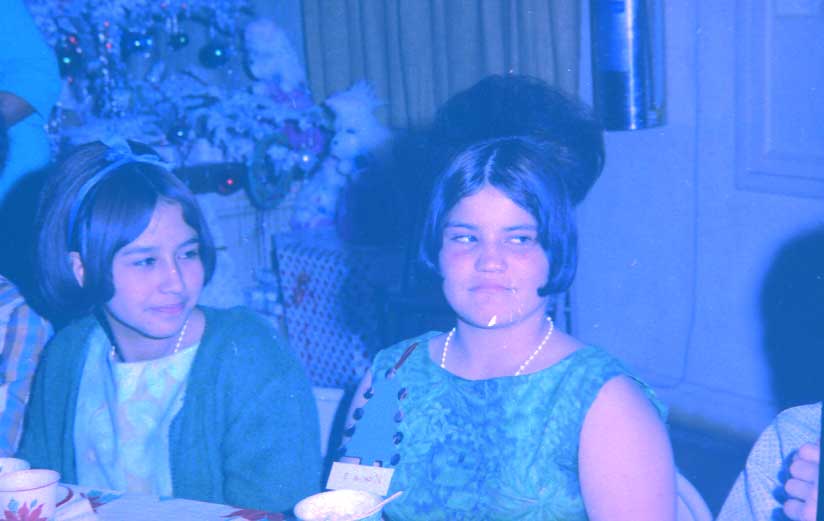
Photo of a Christmas Party at MacLaren Hall in the 1960's (photos courtesy of the archives of Mr. and Mrs. Vincent Graziano. Mr. Graziano volunteered as the Santa at Mac Hall for years.)
Los Angeles Times, March 30, 1961: "...the former home for polio victims…will become a "home away from home" for 148 children now being cared for in overcrowded Juvenile Hall in Los Angeles. The new occupants are dependent and neglected children from broken families who must be held temporarily in protective custody, officials said…The county is presently organizing an auxiliary of Valley residents to assist MacLaren's staff in providing recreation for the young occupants."
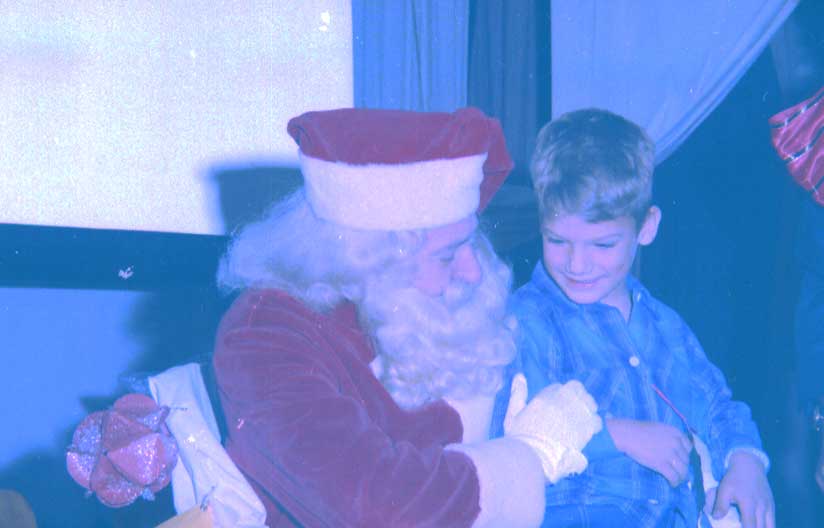
Photo of a Christmas Party at MacLaren Hall in the 1960's (photos courtesy of the archives of Mr. and Mrs. Vincent Graziano. Mr. Graziano volunteered as the Santa at Mac Hall for years.)
Los Angeles Times, November 6, 1960: "The county purchased this," he added, "for the simple reason that there is no other place where the county could get this much bed space at so cheap a price." Most of the buildings were not up to code standards. Disterdick said the kitchen will have to be completely remodeled. The work is being done on three separate contracts as follows: Landscaping and developing of existing buildings to meet the needs of 148 wards and 100 staff employees. Installing perimeter security measures, which include flood lights and a 14 foot chain link fence, topped by five feet of wire mesh. Drilling an additional water well, and linking the facility's underground water system to the municipal water network of El Monte. The latter two commitments are completed. Among new features will be a small courtroom in one wing which will make it unnecessary for authorities to transport a child to Los Angeles for hearings, and a library. "MacLaren Hall is actually expected to enhance property values in the surrounding neighborhoods," said Kenny Kirkpatrick, director of all juvenile facilities in the county. He said homes in a new tract which recently sprang up across from the hall, are selling for $16,000. "The county is always concerned with this aspect of the operation," said Kirkpatrick. "But so far, in every instance, a facility such as this has always increased values." - Gould, Charles. (1960, November 6). New MacLaren Hall to House Juvenile Wards: Sister Kenny Polio Hospital Being Converted by Probation Department.

A man by the name of James who was in Mac Hall in the 1960's found this photo hidden somewhere deep in the Google image archives...
Los Angeles Times, October 10, 1962: "...Mr. Holton did not stress what every citizen should know, namely, that the Probation Department is required to take care of dependent and neglected children as well as those who have been arrested. Many of these babies and children have been physically abused and require medical treatment. Top priority after building the San Fernando Valley branch Juvenile Hall will be given to the buildings at MacLaren Hall, where these unfortunate children are kept until homes can be found for them. In addition to hospital facilities, the number of beds now available there does not meet current demands...The League of Women Voters supported the bond issue of 1956. This money has been used wisely for the construction and expansion of branch juvenile facilities which are now so overcrowded that the saturation point has been reached. We are one of the richest as well as the fastest growing counties in the United States. It is shameful to allow children to sleep on the floor in any juvenile facility. Let us not confuse the issue. Let us work for the 2/3's majority to pass Proposition A. - Mrs. Robert Lord, Board of Directors, League of Women Voters of Los Angeles County
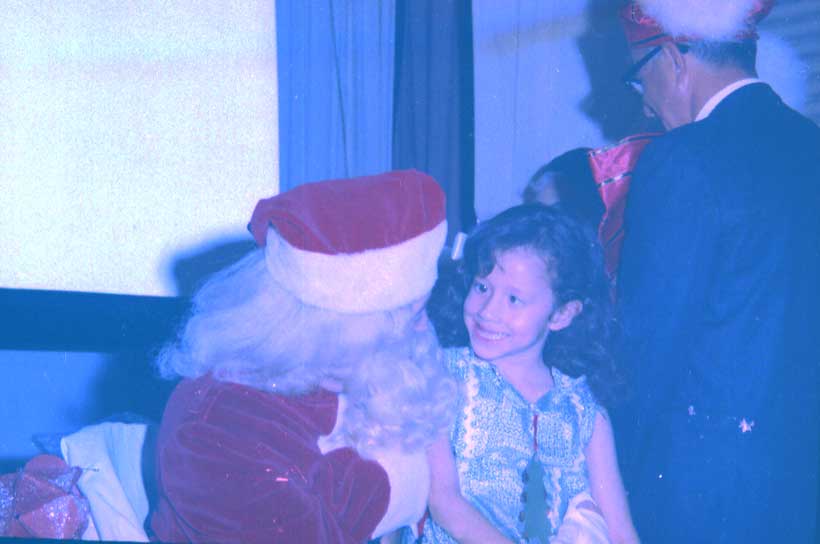
Photo of a Christmas Party at MacLaren Hall in the 1960's (photos courtesy of the archives of Mr. and Mrs. Vincent Graziano. Mr. Graziano volunteered as the Santa at Mac Hall for years.)
Los Angeles Times, September 20, 1961: "The County Grand Jury will be asked today to consider first degree murder indictments against the foster parents of Carolyn Page, the 5 year old girl who died while tied to a shower as punishment. Clarence, 40, and Ruth Van Buren, 41, of 14522 Dora Drive, La Mirada, were booked on suspicion of murder on Sunday after leading Sheriff's detectives to the girl's abandoned body near La Jolla. The Van Burens, paid by the county to care for Carolyn and her younger brother and sister, said Carolyn died accidentally Aug. 13, while lashed to a shower. The couple said she apparently got her neck caught in the wire binds sometime during the 6 hours she was left tied up. They said they became panicky and discarded her body. Sheriff homicide Sgt. Claude Human will go before the criminal complaints committee of the grand jury at 9 a.m. to seek a hearing leading to an indictment. The two other Page children, Glenn, 3, and Dovie, 2, are being held in MacLaren Hall in El Monte along with the 3 month old son the Van Burens adopted last June. The Page children came under county custody in April 1960, when their natural mother slit their wrists in a murder-suicide plot." - Los Angeles Times. (1961, September 20). Murder Charge to Be Asked in Carolyn Death.
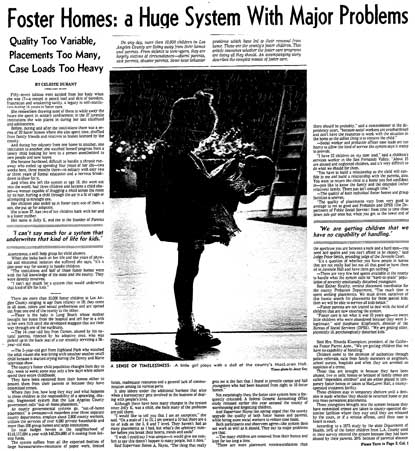
Los Angeles Times Dec 4., 1977 article about MacLaren Hall (page D1)


